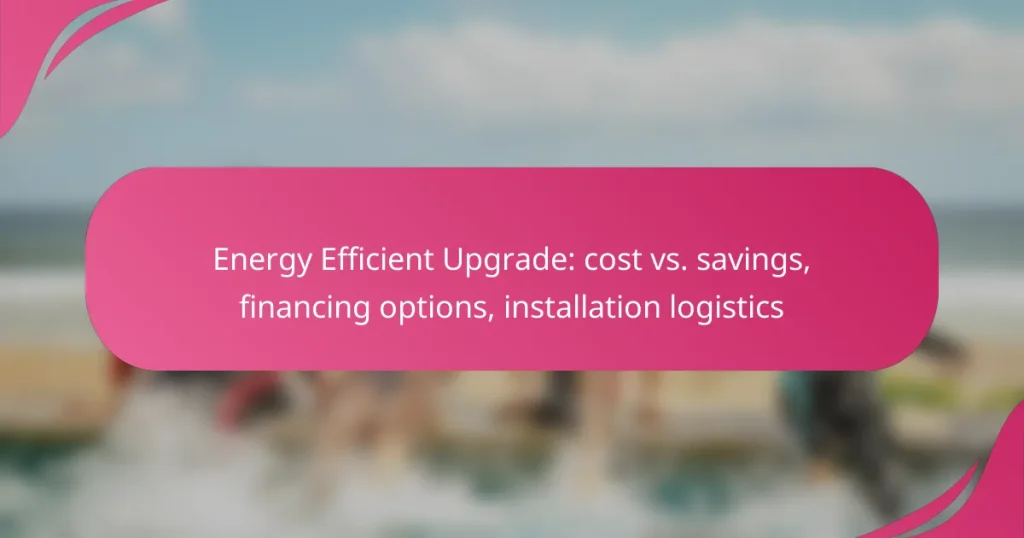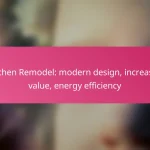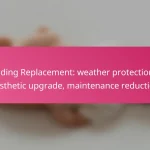Investing in energy efficient upgrades can lead to substantial savings on utility bills, with reductions typically between 10% and 30% annually. Homeowners have access to various financing options, such as tax credits and specialized loans, to facilitate these improvements. By carefully assessing installation costs, including materials and labor, homeowners can effectively budget for upgrades while maximizing long-term savings.
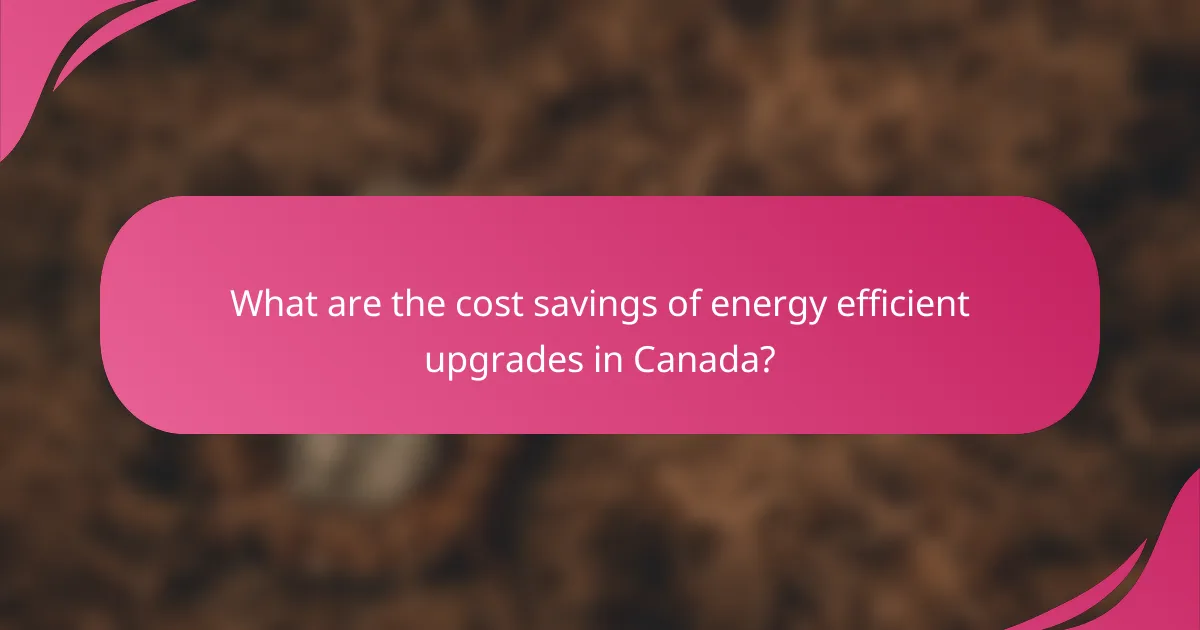
What are the cost savings of energy efficient upgrades in Canada?
Energy efficient upgrades in Canada can lead to significant cost savings on utility bills, often ranging from 10% to 30% annually. These upgrades not only reduce energy consumption but also lower greenhouse gas emissions, contributing to a more sustainable environment.
Long-term utility savings
Investing in energy efficient upgrades typically results in long-term utility savings. For example, replacing old heating systems with high-efficiency models can reduce heating costs substantially over time. Homeowners can expect to see a return on investment within a few years, depending on the specific upgrades and local energy prices.
To maximize savings, consider conducting an energy audit to identify the most impactful upgrades. Common improvements include better insulation, energy-efficient windows, and smart thermostats, all of which can lead to lower monthly energy bills.
Increased property value
Energy efficient upgrades can enhance property value, making homes more attractive to potential buyers. Properties with modern energy-efficient features often sell faster and at higher prices compared to those without. In some cases, the increase in value can be significant, sometimes exceeding the cost of the upgrades.
When marketing a home, highlight energy-efficient features such as Energy Star appliances, solar panels, and high-efficiency HVAC systems. These elements not only appeal to environmentally conscious buyers but also signify lower future utility costs.
Government incentives
In Canada, various government incentives are available to encourage energy efficient upgrades. Programs may include rebates, tax credits, or grants that can offset the initial costs of improvements. For instance, the Canada Greener Homes Grant offers financial assistance for energy retrofits, making upgrades more affordable.
Homeowners should research local and provincial programs, as incentives can vary widely. Staying informed about these opportunities can significantly reduce the financial burden of energy efficient upgrades, enhancing both savings and property value.

What financing options are available for energy efficient upgrades?
Several financing options exist for energy efficient upgrades, making it easier for homeowners to invest in improvements that reduce energy consumption and costs. These options can include tax credits, specialized loans, and various financing programs designed to support energy efficiency projects.
Home Energy Renovation Tax Credit
The Home Energy Renovation Tax Credit allows homeowners to receive a tax credit for a portion of their expenses related to energy-efficient upgrades. This credit can significantly reduce the overall cost of renovations, making it a valuable incentive for those looking to improve their home’s energy performance.
To qualify, homeowners must ensure that the upgrades meet specific energy efficiency standards set by the government. Common eligible improvements include insulation, energy-efficient windows, and heating or cooling systems. It’s advisable to keep detailed records of expenses and consult a tax professional to maximize benefits.
Green Home Loan Program
The Green Home Loan Program offers low-interest loans specifically for energy-efficient home improvements. This program is designed to help homeowners finance upgrades without incurring high upfront costs, making it easier to implement necessary changes.
Typically, these loans cover a range of improvements, including solar panel installations and high-efficiency appliances. Homeowners should compare interest rates and terms from different lenders to find the most favorable options. Additionally, some programs may offer deferred payment plans, which can ease financial burdens during installation.
Energy Efficiency Financing Programs
Energy efficiency financing programs are often provided by local or state governments and utility companies to encourage homeowners to make energy-saving upgrades. These programs can include rebates, grants, or low-interest loans aimed at reducing the financial barriers associated with energy-efficient renovations.
Homeowners should research available programs in their area, as offerings can vary widely. It’s essential to check eligibility requirements and application processes, as some programs may require pre-approval or specific documentation. Engaging with local energy efficiency organizations can also provide valuable insights and assistance in navigating these options.
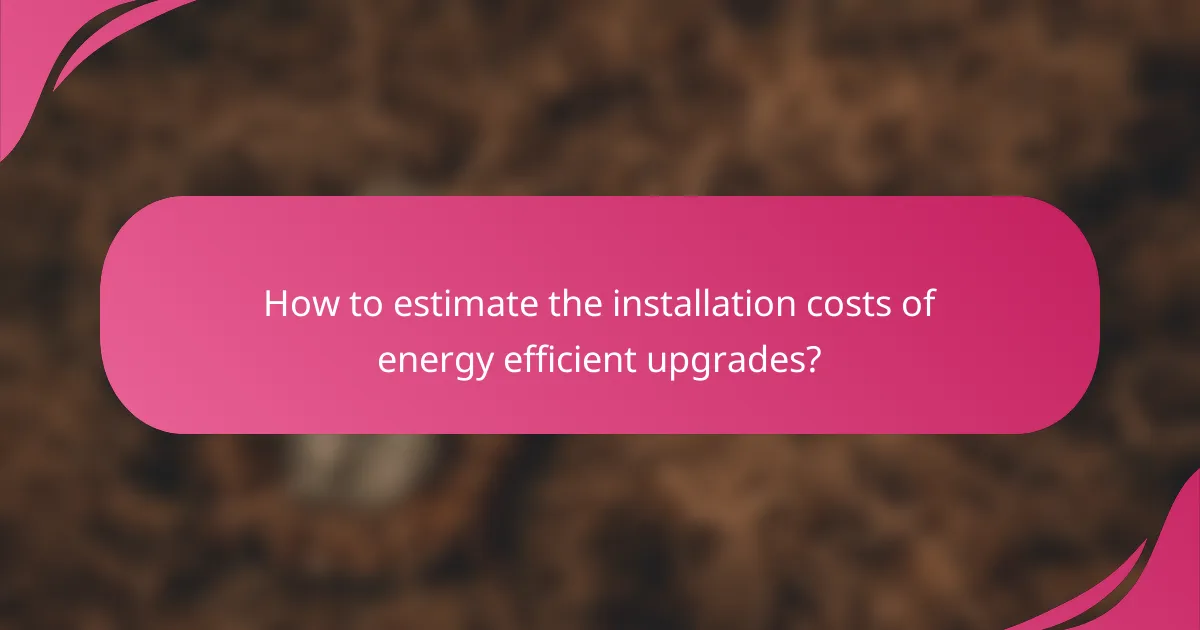
How to estimate the installation costs of energy efficient upgrades?
Estimating the installation costs of energy efficient upgrades involves assessing various factors, including materials, labor, and project scope. Understanding these elements can help homeowners budget effectively and identify potential savings over time.
Average installation costs for insulation
The average installation costs for insulation can vary significantly based on the type of insulation used and the area being insulated. Generally, homeowners can expect to pay between $1.50 to $3.50 per square foot for materials and installation. For example, spray foam insulation tends to be on the higher end, while fiberglass batts are often more affordable.
When estimating costs, consider the R-value needed for your climate zone, as higher R-values may require more expensive materials. Additionally, local labor rates can influence overall expenses, so obtaining multiple quotes from contractors is advisable.
Cost breakdown for energy-efficient windows
Energy-efficient windows typically range from $300 to $1,000 per window, including installation. The cost depends on factors such as window size, frame material, and glazing options. Double-pane windows are a common choice, offering a good balance between cost and energy savings.
When budgeting for window upgrades, factor in potential rebates or tax incentives that may be available for energy-efficient home improvements. These can significantly reduce the overall investment, making it more financially feasible.
Labor costs for HVAC upgrades
Labor costs for HVAC upgrades can vary widely, typically ranging from $50 to $150 per hour, depending on the complexity of the installation and the contractor’s experience. For a complete system replacement, homeowners might pay between $2,500 to $7,500, including both equipment and labor.
It’s essential to choose a licensed and experienced HVAC contractor to ensure proper installation and compliance with local codes. Always request detailed estimates and check references to avoid unexpected costs or issues down the line.
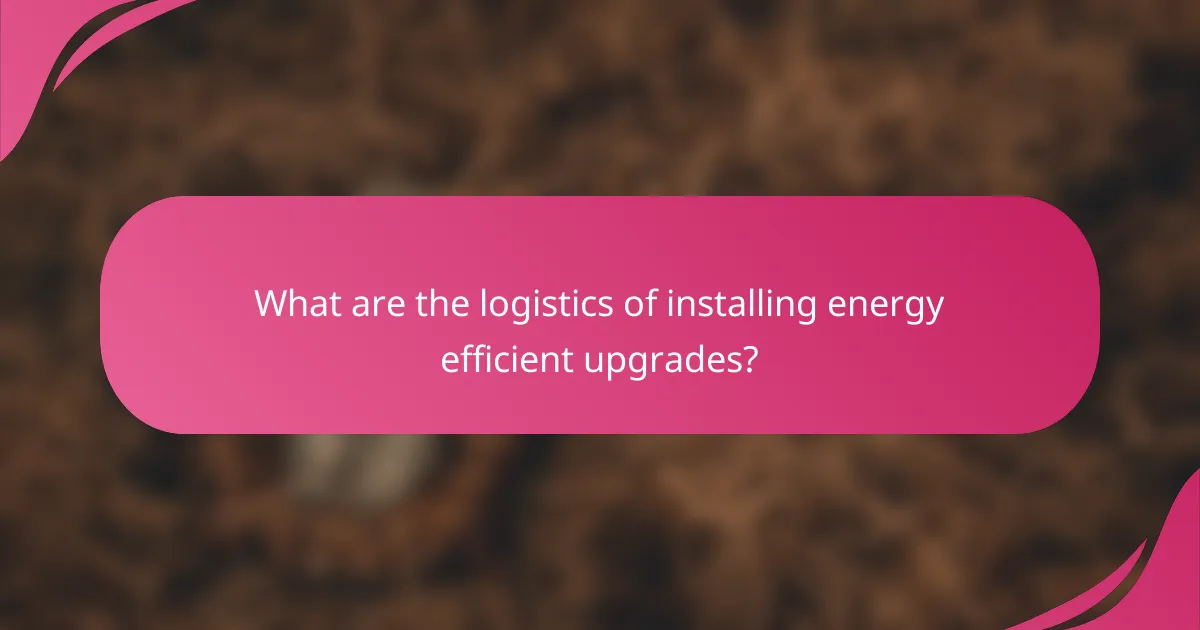
What are the logistics of installing energy efficient upgrades?
Installing energy efficient upgrades involves careful planning and execution to ensure optimal performance and compliance with regulations. Key logistics include understanding the installation timeline, securing necessary permits, and selecting qualified contractors.
Timeline for installation
The installation timeline for energy efficient upgrades can vary significantly based on the type of upgrade and the complexity of the project. Generally, homeowners should expect the process to take anywhere from a few days to several weeks. For example, simple upgrades like insulation may take less time, while more complex systems like solar panels could require extensive planning and installation time.
It’s advisable to schedule a pre-installation assessment to determine the specific needs of your home, which can help streamline the process. This assessment can take a few hours, but it provides valuable insights that can reduce delays during actual installation.
Permits and regulations in Canada
In Canada, obtaining permits for energy efficient upgrades is often a necessary step to ensure compliance with local building codes and regulations. The requirements can vary by province and municipality, so it’s essential to check with local authorities before starting any work.
Common upgrades that may require permits include major renovations, installation of solar panels, and significant HVAC changes. Failing to secure the proper permits can lead to fines or the need to remove the upgrades, which can be costly and time-consuming.
Choosing qualified contractors
Selecting qualified contractors is crucial for the successful installation of energy efficient upgrades. Look for contractors who specialize in energy efficiency and have relevant certifications, such as those from the Canadian Home Builders’ Association or similar organizations. Checking references and reviews can also provide insights into their reliability and quality of work.
It’s beneficial to obtain multiple quotes to compare pricing and services offered. Ensure that the contractors are familiar with local regulations and can assist with the permitting process, as this can save time and prevent potential issues during installation.

What are the prerequisites for energy efficient upgrades?
Before undertaking energy efficient upgrades, homeowners should assess their current energy consumption and identify areas for improvement. Understanding the prerequisites ensures that upgrades are effective and tailored to specific needs.
Home energy audit requirements
A home energy audit is essential to pinpoint inefficiencies and determine the best upgrades. Many utility companies offer free or subsidized audits, which typically involve a thorough examination of insulation, heating and cooling systems, and appliances.
During the audit, a professional may use specialized tools, such as blower doors and thermal imaging cameras, to assess air leaks and insulation quality. Homeowners should ensure that the auditor is certified and follows recognized standards, such as those set by the Residential Energy Services Network (RESNET).
Assessing existing systems
Evaluating existing systems is crucial before making any upgrades. Homeowners should review the age, efficiency ratings, and maintenance history of their heating, cooling, and water heating systems. This assessment helps identify which systems are worth upgrading and which may need replacement.
For example, if a furnace is over 15 years old and has a low efficiency rating, replacing it with a high-efficiency model could yield significant energy savings. Homeowners should also consider local climate conditions, as they can influence the effectiveness of certain upgrades.

What are the emerging trends in energy efficiency upgrades?
Emerging trends in energy efficiency upgrades focus on advanced technologies, sustainable materials, and smart home integration. These innovations aim to reduce energy consumption while maximizing cost savings and environmental benefits.
Cost vs. Savings
When considering energy efficiency upgrades, it’s crucial to weigh the initial costs against long-term savings. Upgrades like high-efficiency HVAC systems or insulation can require significant upfront investment but often lead to substantial reductions in energy bills over time.
For instance, homeowners might spend a few thousand dollars on a new heating system but could save 20-30% on their heating costs annually. Evaluating payback periods—typically ranging from 3 to 10 years—can help determine if an upgrade is financially viable.
Financing Options
Various financing options are available for energy efficiency upgrades, making them more accessible. Homeowners can explore low-interest loans, energy efficiency rebates, and even tax credits that can offset initial costs.
Programs like Property Assessed Clean Energy (PACE) allow homeowners to finance upgrades through property taxes, spreading the cost over time. Additionally, local utility companies may offer incentives or financing plans to encourage energy-saving improvements.
Installation Logistics
Installation logistics for energy efficiency upgrades involve planning and coordination to minimize disruption. Homeowners should schedule installations during off-peak seasons to avoid delays and ensure contractors are available.
It’s advisable to obtain multiple quotes from qualified contractors to compare pricing and timelines. Checking for certifications and reviews can help ensure quality work. Planning for potential disruptions, such as temporary loss of heating or cooling, is also essential for a smooth upgrade process.
